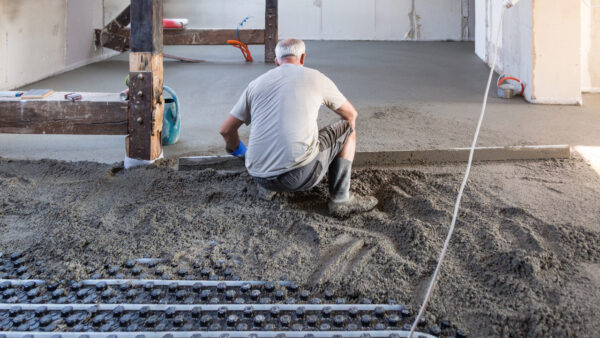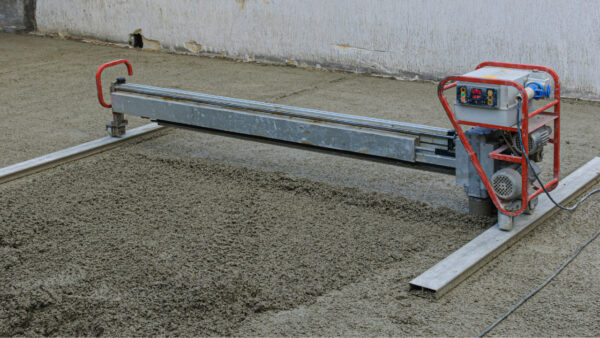Table of Contents
What is Screed?
Screed is a combination of sand and cement which is placed atop a concrete base to provide a strong, smooth and stable surface. This makes it convenient to apply the final floor layer and finish off the surface with a neat look.
Screed can either be applied on a concrete slab directly or by first laying a damp-proof course or any insulation layer/s and placing it on top of it.
Screed is considered to be one of the best materials for underfloor covering for heating system.

Laying of screed for floor heating system
What is Screed Used For?
The purpose of laying screed on the top of concrete floor is to form a smooth and flat surface to lay other flooring on the top of it including vinyl carpets, lamination boards, floor boards, etc.
Screed can help ensure the surface for subsequent flooring is completely level. It can either be directly bonded to the underlying concrete surface or a membrane can be placed between the two.
The thickness of screed depends upon the concrete strength lying underneath. If screed is being laid atop a rigid concrete pavement that is subjected to heavy traffic loading such as in a commercial or industrial area.
However, for domestic settings or other areas where the concrete is not subjected to heavy loads, a screed of thickness 25mm of bonded screed or 65mm of unbonded screed will suffice.
Types of Screed Applications
Bonded Screed
The term “bonded” means that the screed is laid directly against the concrete slab using a bonding agent. To do so, the underlying concrete has to be made rough and to increase the reliability of bond and a strong bonding agent is used.
Prior to laying the screed and bonding it to the substrate, it must be ensured that the surface of the substrate is free from dust or any other contaminants. To do so, the surface should be cleaned and made sound.
Unbonded Screed
This type of screed is not directly laid on the top of a concrete surface. Instead, it is laid of a PVC membrane that is present on the concrete surface. Depending upon the utilization of area, this type of screed can be of the following types.
- Reinforced screed contains added fibers (especially polypropylene fibers) for augmenting its strength. The reinforcement to screed can also be provided by placing ordinary screed onto a metal mesh that serves as a reinforcing material. This helps minimize shrinkage cracking in the screed.
- Self-levelling screed is another name for self-compacting screed. Just like self-compacting concrete, it does not require an external compactive effort, however, the minimal effort for aiding the levelling process is to be employed using dapple bars.
- Wearing screed is a type that can directly serve as a finishing floor and no extra carper or flooring material is laid on top of it.
How to Screed Floors?
- Make levels around the edge of the area where screeding is to be done. To do this, pour the screed along the edges first and smooth it off with a spade.
- Obtain a thickness roughly equal to the level of the desired finish floor.
- Using the screed rule or straight edge, compact the screed using a forward and backward motion.
- Once you have the level guides around the edges, you can start with the infilling the screed.
- Using the edges as guides, rule in the screed in the forward and backward motion and get the same floor level as that of the edges.
- Once and area is laid with screed and properly ruled, use a float to neaten the edges and surface making sure not to dig in. At this stage, if some holes become apparent on the surface of the screed, they can be filled with some more screed and levelled off using a float.
- Once an area is floated up, use a steel trowel and give it a nice going over the surface to remove any irregularities that still remain.
- Repeat the above process, floating and trowelling to get a smooth and finished surface.
- It is important to do the main section or the center of the area to be screeded at the end. And the compact rule is used at each stage as a guide to check, compact, and level off the surface.

Levelling off screed surface with a trowel
Applications
Prior to laying, it is important to understand the purpose and area where the screed is to be laid. Reinforced screeds contain polypropylene fibers that are added for extra strength. However, metallic or glass fibers may also serve the purpose but they are generally suited for heavy traffic. This is because they possess a higher strength and flexibility and this can help reduce the risks of screed curling and cracking as it dries.
Screed is also used when underfloor heating systems are installed. The heating system is installed above the concrete floor and the laying screed helps level off the surface to make room for final floor finish in the form of tiles, marble, etc.

Floor heating system to be covered with screed layer
Bonded screed is used in factories and warehouses as a structural part of substrate. This means that laying screed also serves to bear the wear of applied heavy loads.
In areas that are prone to moisture ingress or dampness, screed is laid on top of the damp-proof membrane. It serves to increase the resistance of the floor to dampness.
Required Minimum Thickness of Screed
If we talk about the minimum thickness of screed made from cement and sand, it depends upon the nature of bond between the substrate and the screed. In this regard, we have three categories as discussed previously namely bonded screed, unbonded screed, and screed for floating construction as in case of thermal or acoustic insulation.
- The minimum thickness of bonded screed comprising sand, cement and some admixture or plasticizer used to modify its properties is 10 mm.
- For a traditional sand and cement screed having cement and sand in the ratio 1 to 4 or 1 to 3, the minimum thickness of screed as recommended by the British standards is 40 mil.
- In case of unbonded screed having an intervening membrane on top of the substate and some admixture added to modify its properties, the minimum thickness of screed should be 35 mil.
- For a traditional unbonded screed having no admixture or plasticizer added, the minimum thickness of screed should be 50 mil.
- In case of floating construction, if modified screed comprising some admixture is used, the minimum thickness recommended is 35 mil.
- For floating screed, the minimum recommended thickness for traditional cement, sand screed is 65 mil for domestic construction and 75 for commercial construction.
Minimum Requirements of Floor Screed
- The strength of screed used for domestic construction should be 20 MPa and that used for industrial application should be 30 MPa.
- It is important to level off the top surface of screed properly and ensure that no pot holes or voids are open at the surface level.
- In order to prevent rapid shrinkage and cracking of screed, it must be properly cured when hardened.
Difference between Concrete and Screed?
Concrete is a lot coarser than screed. Although both of them essentially have the same ingredients, the aggregates used in concrete are larger than those used in screed. A possible reason to this is that concrete is used for purposes of strength whereas screed is used for just getting a smooth top surface.
It is also possible to entirely exclude coarse aggregates during the manufacturing of screed and only use sharp sand, cement and water. However, the addition of coarser aggregates depends upon the purpose screed laying will serve.
If the screed is to bear heavy loads, coarse aggregates are usually added and if it is only laid as a floor covering, the coarser aggregate can be neglected.
Frequently Asked Questions
What is the purpose of providing a membrane in case of unbonded screed?
In unbonded screed, the substrate (i.e., the underlying concrete) is not directly bonded with the screed and a membrane is placed in between the two. The membrane can serve the purpose of damp-proofness and will rescind the entry of moisture at the floor level.







